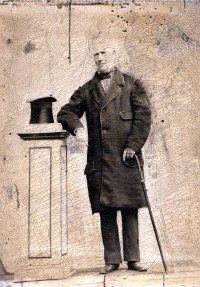
Patented by the Frenchman André Adolphe Eugéne Disdéri in 1854, the carte de visite or visiting card is a hard copy (usually albumen) taken from a collodion negative. The image, in 58 x 94 mm format, is glued on a cardboard of approximately 63 x 102mm. The photographs were taken with special cameras with four, six and even eight lenses to obtain the same number of views on a single plate. The system made portraiture much cheaper and was widely used in Europe throughout the 1860s. A stereoscopic photograph is an image produced by a camera equipped with two lenses placed at a distance from each other similar to the distance between the eyes (about 7 centimetres): the method is therefore based on human binocular vision. Contemplating the two images with the appropriate viewer, the observer perceives a single image in three dimensions. At the Universal Exhibition of 1851, stereoscopic daguerreotypes taken by Jules Duboscq were already on display, and soon after the stereoscopic positives on paper were mounted on cardboard and sold at very low prices. The interest in stereoscopy did not wan until well into the 20th century. Autochrome, invented by Auguste and Louis Lumiére and presented by themselves in 1904 at the Academy of Sciences in Paris, was the first color photography process that enjoyed true diffusion from its commercialization in 1907. The glass plate it was covered with an emulsion composed of grains of starch (potato starch) dyed in trichome, a mosaic that filtered the light before it affected the silver layer. The use of autochrome continued until the 1930s, when it was replaced by the more perfect subtractive synthesis systems such as Kodacolor and Agfacolor. The Museum collection includes dozens of cartes de visite, numerous stereoscopic views on crystals and even some autochromes, but there are also many old pieces that correspond to other typologies.
 Patented by the Frenchman André Adolphe Eugéne Disdéri in 1854, the carte de visite or visiting card is a hard copy (usually albumen) taken from a collodion negative. The image, in 58 x 94 mm format, is glued on a cardboard of approximately 63 x 102mm. The photographs were taken with special cameras with four, six and even eight lenses to obtain the same number of views on a single plate. The system made portraiture much cheaper and was widely used in Europe throughout the 1860s. A stereoscopic photograph is an image produced by a camera equipped with two lenses placed at a distance from each other similar to the distance between the eyes (about 7 centimetres): the method is therefore based on human binocular vision. Contemplating the two images with the appropriate viewer, the observer perceives a single image in three dimensions. At the Universal Exhibition of 1851, stereoscopic daguerreotypes taken by Jules Duboscq were already on display, and soon after the stereoscopic positives on paper were mounted on cardboard and sold at very low prices. The interest in stereoscopy did not wan until well into the 20th century. Autochrome, invented by Auguste and Louis Lumiére and presented by themselves in 1904 at the Academy of Sciences in Paris, was the first color photography process that enjoyed true diffusion from its commercialization in 1907. The glass plate it was covered with an emulsion composed of grains of starch (potato starch) dyed in trichome, a mosaic that filtered the light before it affected the silver layer. The use of autochrome continued until the 1930s, when it was replaced by the more perfect subtractive synthesis systems such as Kodacolor and Agfacolor. The Museum collection includes dozens of cartes de visite, numerous stereoscopic views on crystals and even some autochromes, but there are also many old pieces that correspond to other typologies.
Patented by the Frenchman André Adolphe Eugéne Disdéri in 1854, the carte de visite or visiting card is a hard copy (usually albumen) taken from a collodion negative. The image, in 58 x 94 mm format, is glued on a cardboard of approximately 63 x 102mm. The photographs were taken with special cameras with four, six and even eight lenses to obtain the same number of views on a single plate. The system made portraiture much cheaper and was widely used in Europe throughout the 1860s. A stereoscopic photograph is an image produced by a camera equipped with two lenses placed at a distance from each other similar to the distance between the eyes (about 7 centimetres): the method is therefore based on human binocular vision. Contemplating the two images with the appropriate viewer, the observer perceives a single image in three dimensions. At the Universal Exhibition of 1851, stereoscopic daguerreotypes taken by Jules Duboscq were already on display, and soon after the stereoscopic positives on paper were mounted on cardboard and sold at very low prices. The interest in stereoscopy did not wan until well into the 20th century. Autochrome, invented by Auguste and Louis Lumiére and presented by themselves in 1904 at the Academy of Sciences in Paris, was the first color photography process that enjoyed true diffusion from its commercialization in 1907. The glass plate it was covered with an emulsion composed of grains of starch (potato starch) dyed in trichome, a mosaic that filtered the light before it affected the silver layer. The use of autochrome continued until the 1930s, when it was replaced by the more perfect subtractive synthesis systems such as Kodacolor and Agfacolor. The Museum collection includes dozens of cartes de visite, numerous stereoscopic views on crystals and even some autochromes, but there are also many old pieces that correspond to other typologies. 